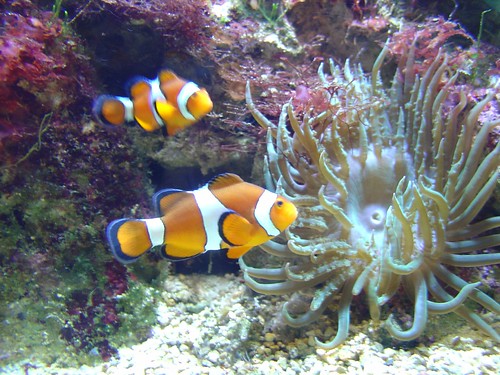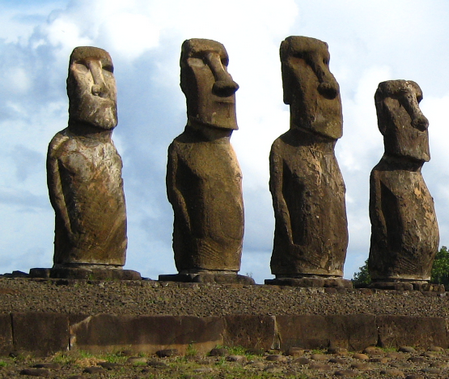Whenever you dive I'm sure that you always meet the group of cute clownfish which enliven the underwater world. However, are you sure that you have already known them well, if you say no, let's see the following interesting info quickly.
Photo: Arne Kuilman
Clownfish and anemonefish are fishes from the subfamily Amphiprioninae in the family Pomacentridae. About twenty eight species are recognized, one in the genus Premnas, while the remaining are in the genus Amphiprion. In the wild they all form symbiotic mutualisms with sea anemones. Depending on species, clownfish are overall yellow, orange, reddish, or blackish, and many show white bars or patches and the tips of their fins have a thin black rounded stripe. The largest reach a length of 18 cm, while the smallest barely reach 10 cm. Also, they live at the bottom of the sea in sheltered reefs or in shallow lagoons, usually in pairs.
Furthermore, the unique qualification of them that made me surprised is about the reproduction. Clownfish live in small groups inhabiting a single anemone. The group consists of a breeding pair, which cohabits with a few non-reproductive, "pre-pubescent", and smaller male clownfish. When the female dies, the dominant male changes sex and becomes the female. This life history strategy is known as sequential hermaphroditism. In addition, clownfish are all born as males, they are protandrous hermaphrodites which are in contrast with another form of hermaphroditism, known as protogyny, in which all fish are born as females but can change to males later. Clownfish can lay hundreds or thousands of eggs depend on the species and they were the first type of marine ornamental fish to be successfully bred in captivity on a large scale.
Photo: emphasis
Normally, Clownfish are not eaten by other fish and live safely at the quiet corners of the Coral reef. But, their greatest threat is human. If you don't believe me, you can see that many of them are living in the aquarium or at the rich man's home and many Coral reefs have been destroyed by human too. Moreover, Clownfish become popular for now so I'm afraid that you will not see them in the nature in the future.
Anyway, it's a good luck for them that some conservationists have found the method for helping them like raising them and their habitat. But, you can also be the part of preserving Clownfish, no need to do the great thing and spend too much money; you just begin to aware of the nature around you. Not only the aquatic animals but you can also attend to all environments in our world.
Tuesday, September 15, 2009
Clownfish (Anemonefish) – The Little Beautiful Fish in Marine
Labels: anemonefish, Clownfish, coral reef
Posted by ThanateTan at 1:46 AM 0 comments
Tuesday, September 1, 2009
Underwater Moai - Rapa Nui
On dry land our dive master turned guide and we headed off to Rano Raraku, a kind of quarry from which the original Moai were carved centuries ago. It's a strange place and the remnant of an extinct volcano. Wild horses drink in its crater lake. Dozens of Moai are scattered in the vicinity; the ones that never made it to their intended resting places. Down at 20 meters there was a surprise with underwater Moai. It was a replica, the dive master told us it was dropped down there by a local as a remembrance.
Photo: untitled-project.com
Some stand half buried, others have fallen and many more remain unfinished, part carved from the mountainside. Most are about 6-8 metres tall, though the largest is unfinished and a whopping 21 metres. No metal tools were used to create the Moai, instead they were carved using stone on stone. How the Moai came to stand at their various resting places around the island remains a mystery.
"Rapa Nui" or "Easter Island" is a Polynesian island in the southeastern Pacific Ocean, at the southeastern most point of the Polynesian triangle. A special territory of Chile annexed in 1888, Easter Island is widely famous for its monumental statues, called moai which created by the Rapanui people.
Rapa Nui is a world heritage site with much of the island protected within the Rapa Nui National Park. one of the world's most remote inhabited islands, is no less an nigma than how their descendants could design and sculpt hundred of colossal moai from hard volcanic tuff, transport these tall and heavy statues great distances from quarry to coast and erect them on great stone ahu (platforms). Residents and visitors have applied various names to this small, isolated volcanic land-mass.
Photo: designer-daily.com
The Polynesian settlers named it Rapa Nui, but the view of the seemingly infinite sea from the summit of Terevaka, the island's highest point, reveals why they also called it Te Pito o Te Henua - the Navel or centre of the World. From Eater Island, a vessel can sail any direction with out sighting inhabited land.
Dutch mariner Jacob Roggeveen, the first European to sight the island, named it Easter Island, after the date of his discovery; the Spaniards first called it San Carlos. Other mariners dubbed it Davis's Land after confusing it with territory identified by the 17th-century English pirate Edward Davis. Roggeveen's legacy survived among Europeans. English speakers call it Easter Island. Spanish speakers refer to Isla de Pascua, Germans to Osterinsel.
A further word on terminology: What exactly to call the island in inhabitants and their language has been a topic of hairsplitting contention. It is more probable that Polynesians settled the island from the west. these peoples managed to disperse over a myriad of islands within a gigantic triangle whose apexes were at New Zealand, Hawaii and Rapa Nui, plus a handful of islands deep in Melanesia. Orthodox academic opinion currently favors an Asiatic origin for the Polynesian peoples who, apparently, built the Rapa Nui monuments.
Photo: gordonmackie.com
Details vary, but there is general agreement that migration into the Pacific region began 50,000 years ago, when ancestors of the Australian Aboriginals and New Guinea highlanders first crossed the sea in search of new homelands. some people argue that the two-word term 'Rapa Nui' is an imperial imposition that the single word 'Rapanui' more closely approximates usage in other Polynesian languages.
Source gordonmackie.com, janesoceania.com, untitled-project.com
Labels: Easter Island, Rapa Nui, Underwater Moai
Posted by ThanateTan at 3:09 PM 0 comments

